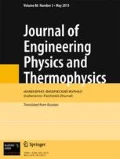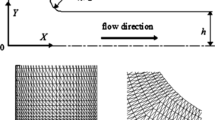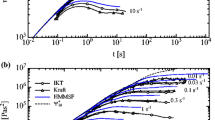The present paper considers the problem of constructing a rheological constitutive relation for melts of branched polymers with the use of a modified Vinogradov–Pokrovskii rheological model generalized to the case of several noninteracting models, each of which corresponds to the account in the stress tensor of the contribution of a particular polymer fraction and is characterized by its own relaxation time and viscosity. Since the number of model parameters markedly increases thereby, simple dependences of its parameters on the mode number are proposed. On the basis of the obtained model, the nonlinear nonstationary effects at simple shear and uniaxial tensor have been considered.
Similar content being viewed by others
References
J. G. Oldroyd, On the formulation of rheological equations of state, Proc. R. Soc. London, A200, 523–541 (1950).
A. I. Leonov and A. N. Prokunin, Nonlinear Phenomena in Flows of Viscoelastic Polymer Fluids, Chapman and Hall, New York (1994).
M. Doi and S. F. Edwards, The Theory of Polymer Dynamics, Oxford, Clarendon (1986).
De Gennes, PG Scaling Concepts in Polymer Physics, Cornell University Press, Ithaca (1979).
R. B. Bird, C. F. Curtiss, R. C. Armstrong, and O. Hassager, Dynamics of Polymeric Fluids, Vol. 2, Wiley, New York, (1987).
H. C. Ottinger, A thermodynamically admissible reptation model for fast flows of entangled polymer, J. Rheol., 43, 1461–1493 (1999).
T. C. B. McLeish and R. G. Larson, Molecular constitutive equations for a class of branched polymers: the pom-pom polymer, J. Rheol., 42, 81–110 (1998).
W. M. H. Verbeeten, G. W. M. Peters, and F. P. T. Baaijens, Differential constitutive equations for polymer melt: the extended pom-pom model, J. Rheol., 45, 821–841 (2001).
M. Zatloukal, Differential viscoelastic constitutive equations for polymer melts in steady shear and elongational flow, J. Non-Newtonian Fluid Mech., 209, 11–27 (2003).
J. Remmelgas, G. Harrison, and L. G. Leal, A differential constitutive equation for entangled polymer solutions, J. Non-Newton Fluid, 80, Nos. 2–3, 115–134 (1999).
T. Borg and E. J. Pääkkönen, Linear viscoelastic model for elongational viscosity by control theory, Rheol. Acta, 13, 371–384 (2011).
G. Bishko, T. C. B. McLeish, O. G. Harlen, and R. G. Larson, Theoretical molecular rheology of branched polymers in simple and complex flows: the pom-pom model, Phys. Rev. Lett., 79, No. 12, 2352–2355 (1997).
W. M. H. Verbeeten, G. W. M. Peters, and F. P. T. Baaijens, Differential constitutive equations for polymer melts:the extended pom-pom model, J. Rheol., 45, 823–843 (2001).
V. A. Kargin and G. A. Slonimskii, On the deformation of amorphous-liquid linear polymers, Dokl. Akad. Nauk SSSR, 62, No. 2, 239–242 (1948).
P. E. A. Rouse, Theory of the linear viscoelastic properties of dilute solutions of cooling polymers, J. Chem. Phys., 21, No. 7, 1271–1280 (1953).
W. W. Graessley, The entanglement concept in polymer rheology, Adv. Polym. Sci., 16, 1–179 (1974).
V. N. Pokrovskii and G. V. Pyshnograi, Simple forms of the constitutive equation of concentrated solutions and melts of polymers as a corollary of the molecular theory of viscoelasticity, Izv. Akad. Nauk SSSR, Mekh Zhidk. Gaza, No. 1, 71–77 (1991).
V. N. Pokrovskii and V. S. Volkov, Computation of the relaxation times and dynamic modulus of linear polymers on the basis of the monomolecular approximation with self-consistency (a new approach to the theory of viscoelasticity of linear polymers), Vysokomol. Soedin., A20, No. 12, 2700–2706 (1978).
V. N. Pokrovskii, Dynamics of loosely bound linear macromolecules, Usp. Fiz. Nauk, 162, No. 5, 87–121 (1992).
Yu. A. Altukhov, A. S. Gusev, G. V. Pyshnograi, and K. B. Koshelev, Introduction to the Mesoscopic Theory of Fluid Polymer Systems [in Russian], Izd. AltGPA, Barnaul (2012).
G. V. Pyshnograi, V. N. Pokrovskii, Yu. G. Yanovskii, Yu. N. Karnet, and I. F. Obraztsov, Constitutive equation of nonlinear viscoelastic (polymer) media in the zeroth approximation for parameters of the molecular theory and corollary for shear and tension, Dokl. Akad. Nauk, 339, No. 5, 612–615 (1994).
G. V. Pyshnograi, A. S. Gusev, and V. N. Pokrovskii, Constitutive equations for weakly entangled linear polymers, J. Non-Newtonian Fluid Mech., 163, Nos.1–3, 17–28 (2009).
I. É. Golovicheva, S. A. Zinovich, and G. V. Pyshnograi, Influence of molecular mass on the shear and longitudinal viscosity of linear polymers, Prikl. Mekh. Tekh. Fiz., 41, No. 2, 154–160 (2000).
A. S. Gusev, M. A. Makarova, and G. V. Pyshnograi, Mesoscopic equation of state of polymer media and description of the dynamic characteristics based on it, J. Eng. Phys. Thermophys., 78, No. 5, 892–898 (2005).
Al Joda H. N. A., G. L. Afonin, D. A. Merzlikina, P. Filip, R. Pivokonskii, and G. V. Pyshnograi, Modification of the law of internal friction in the mesoscopic theory of fluid polymer media, Mekh. Kompozit. Mater. Konstr., 19, No. 1, 128–140 (2013).
D. A. Merzlikina, P. Filip, R. Pivokonskii, and G. V. Pyshnograi, Multimode rheological model and corollaries for simple shear and tension, Mekh. Kompozit. Mater. Konstr., 19, No. 2, 254–261 (2013).
V. N. Pokrovskii, The Mesoscopic Theory of Polymer Dynamics, 2nd edn., Springer, Dordrecht–Heidelberg–London–New York (2010).
V. H. Rolón-Garrido, R. Pivokonsky, P. Filip, M. Zatloukal, and M. H. Wagner, Modelling elongational and shear rheology of two LDPE melts, Rheol. Acta, 48, 691–697 (2009).
R. Pivokonsky, M. Zatloukal, and P. Filip, On the predictive/fitting capabilities of the advanced differential constitutive equations for branched LDPE melts, J. Non-Newtonian Fluid Mech., 135, 58–67 (2006).
Author information
Authors and Affiliations
Corresponding author
Additional information
Translated from Inzhenerno-Fizicheskii Zhurnal, Vol. 89, No. 3, pp. 643–651, May–June, 2016.
Rights and permissions
About this article
Cite this article
Merzlikina, D.A., Pyshnograi, G.V., Pivokonskii, R. et al. Rheological Model for Describing Viscometric Flows of Melts of Branched Polymers. J Eng Phys Thermophy 89, 652–659 (2016). https://doi.org/10.1007/s10891-016-1423-7
Received:
Published:
Issue Date:
DOI: https://doi.org/10.1007/s10891-016-1423-7




